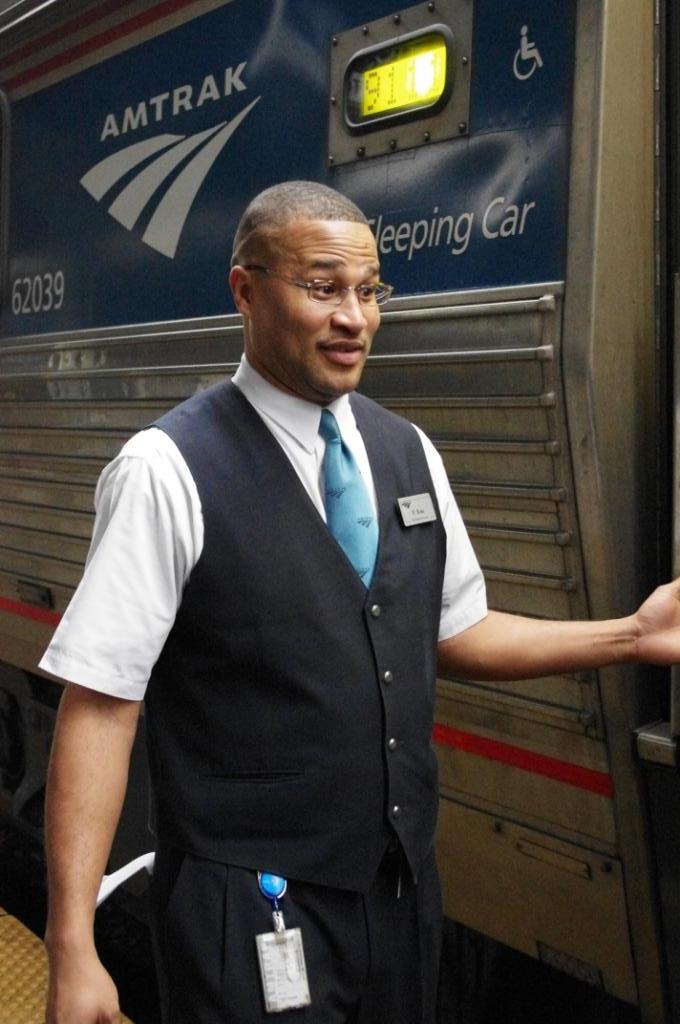Q: Who’s In Charge Here? A: Nobody.
I have traveled on Amtrak a lot. A lot! I have no idea how many miles I have racked up because—stupidly—it was only after six or seven years of serious rail travel in the U.S. that I thought about it and, of course, by then it was too late. I have come up with an estimate, though: close to 200,000 miles.
I’m sure Amtrak must have a prescribed way of doing things: an employee manual where the job descriptions are all spelled out for their on-board employees. Truthfully, I couldn’t tell you what it says, but by now I know a good car attendant or dining car server when I run into one. All things considered, and based on my experience, here’s how I would grade Amtrak’s on-board crews, both car attendants and dining car staffs:
10% – A; 25% – B; 50% – C; 10% – D; 5% – F.
The good dining car employees gravitate to each other because teamwork is important and no one wants a slacker in their crew. That means the odds are that you’ll get a really good dining car crew—working together efficiently and cheerfully. And, trust me, if its not a good crew, you’ll know that right away.

The good car attendants like Preston (left) are really, really good. They like their jobs, they take pride in their work, and they genuinely like people. You know how you can “spot” the bad ones? You rarely see them … and they do the bare minimum. Or they operate at their convenience, not yours … like the car attendant I had a year ago on the Sunset Limited heading for Los Angeles.
We were scheduled to arrive at 5:35 a.m., however sleeping car passengers were told we could stay aboard until 6:30 rather than be rousted out for that very early arrival. That may have been the policy at that time, but the attendant came on the P.A. system in our car at 4:30 a.m., saying she would be coming by in a few minutes to collect the sheets and towels from our rooms. One of the other car attendants told me later that she wanted to catch an early train out of Los Angeles for her home in Fullerton, even if it meant rousting 30 or so paying passengers at 4:30 in the morning.
There was a time, back in the 1980s, when something like that would never happen. There was a Chief of Onboard Services on every long-distance Amtrak train and, believe me, he or she was in charge! Ah, but thanks to the perpetual under-funding of Amtrak by the Congress, the chiefs are long gone.
Still, if you accept my job performance gradings above, it means that some 85% of Amtrak employees are doing an adequate to outstanding job with no on-board supervision. I find that quite remarkable.



Airlines have a Purser, cruise ships include a Director of Hotel Services, and VIA Rail Canada includes on “The Canadian” a Service Director–all for the single, obvious reason–to avoid the “hit or miss” attitudes of unsupervised staff and the impact on the paying customer. The Amtrak concept of “Chief On-Board Services” was valid; however, what apparently got lost in the HR process Amtrak relies upon became self-evident. How are competent, motivated, reliable applicants to be selected when HR itself is not staffed with railroad experienced screeners? Ironically, I witnessed the hiding, lethargic PSR in the 70s and Chief in the 80s–not even a handful were really involved and motivated, whether it was the CZ [California Zephyr], Broadway Ltd, Southwest Chief, or Empire Builder.
What is tolerated now for the on-board experience on Amtrak, particularly for the high priced sleeping cars, will not continue forever. The internal, self-destruction will eventually take its toll–the furnishings, seats and accommodations are just dirty and worn-out-sleepers, diners, “7-11” Superliner cafes, and corridor cafes. For sure, the few competent staff still left must be broken-hearted to not only work with such decrepit equipment and hear the same complaints, but to see how the entire diner experience has been so downgraded–same ol’ menus-every train, every meal period; no holiday decorations or turkey since 2013; no training or supervision to even offer, let alone know how to mix drinks during meal hours; no functioning bar in the cafe, etc. Add into that mix the need for “Express Meals on day of arrival to provide a very abbreviated menu in order to allow the diner staff 4-5 hours to conduct inventory and re-packing.
This is the end result of bowing to the “Mandarin Congress” and the lobbyists who have them on a puppet string. However, there was a different time. David Gunn should have never been forced out as Amtrak CEO, particularly by such a politicized board that found out later how it could not function without his operational knowledge, employee relations, and vision. And Graham Claytor simply died too soon in the job as Amtrak CEO; as he too understood what was needed to bring order to Amtrak. Both were railroaders who had no problem standing up to the whims of Congress in pursuit of their mission.